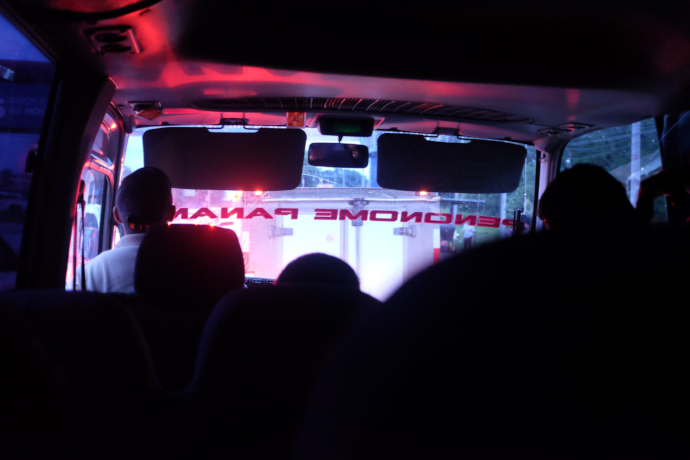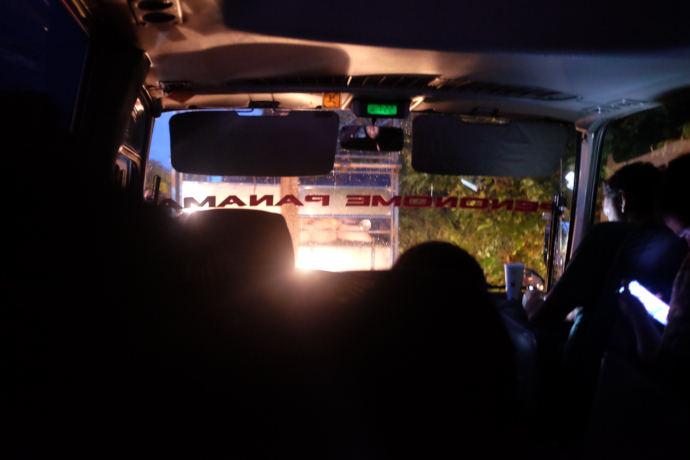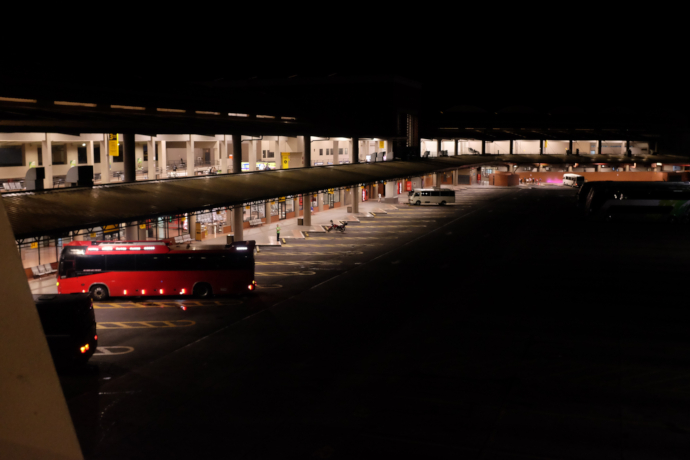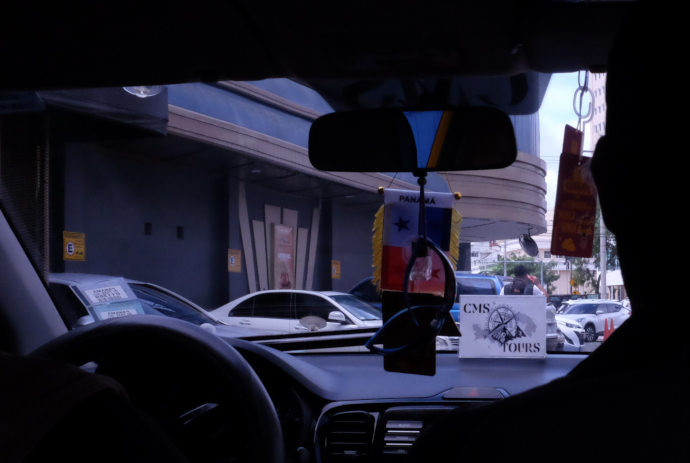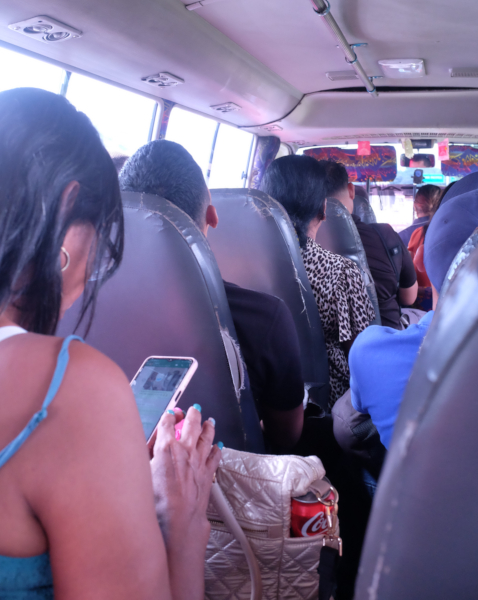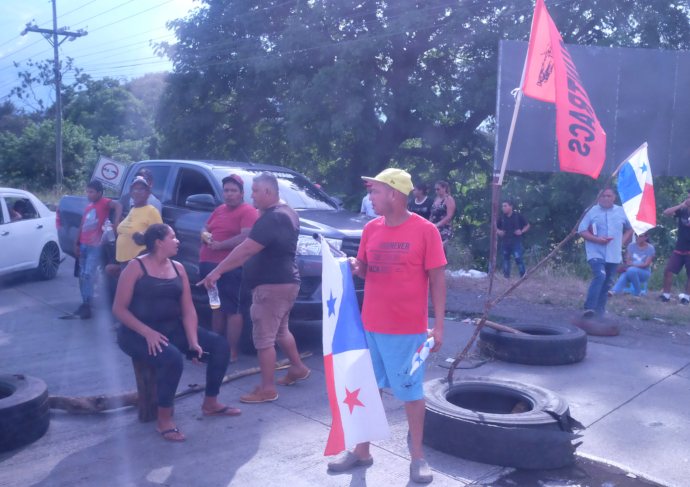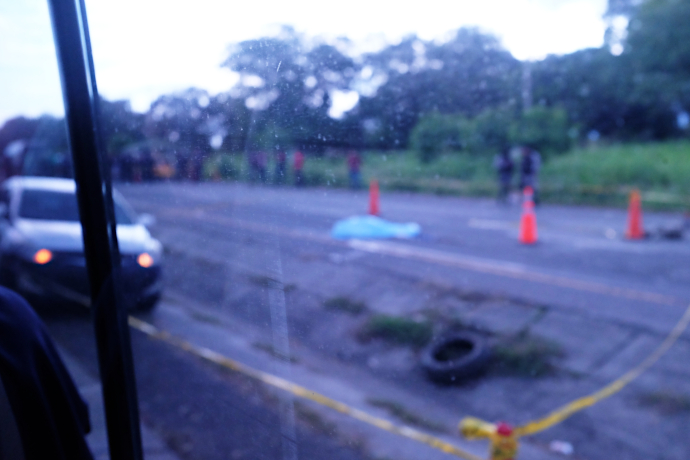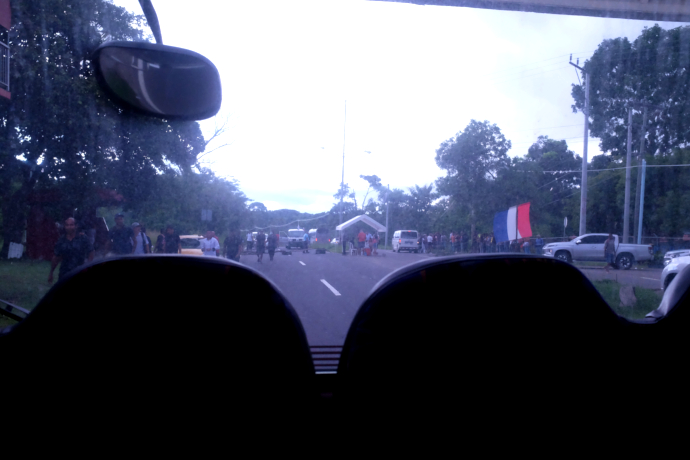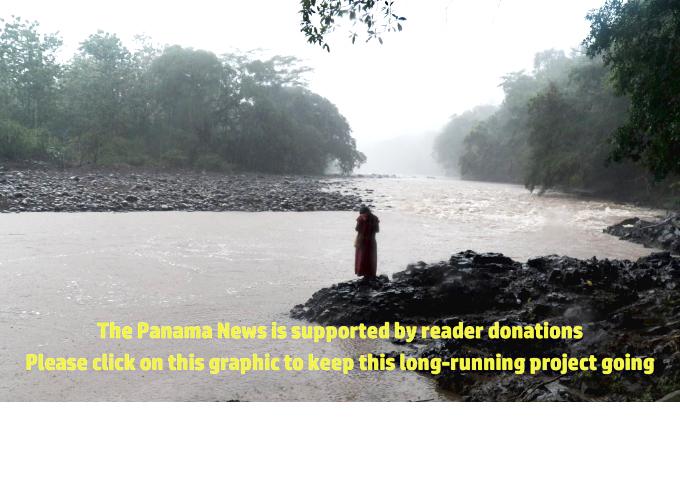Once in Anton, the calculations of unknown equations began.
It took me long enough
photos and article by Eric Jackson
On my part, a long-neglected health issue. For my brother Nick, he is and has been more diligent. As it was, November 7 was our arranged in advance morning to visit a dermatologist in Punta Pacifica, whom we had both seen in the past.
Am I gonna die? Well, I have gotten past the Biblical three score and ten, and should know and do know that sooner or later we all do. But if it’s just an age spot or a cyst or a wart – or a skin cancer that needs to be removed – those are questions best posed to a qualified professional.
As the appointment date approached, Panama was in a roadblock strike. Moreover, his health issues and lifestyle and mine sharply diverge, such that his suggested travel plan would not make sense to me. Overnight at the clean and pleasant but reasonably priced Hotel Marbella in El Cangrejo, a few blocks away from the Via Argentina Metro station, then get a cab to our morning appointments? That works.
Start well in advance the day before and go in together? He’s allergic to dogs and cats. I am surrounded by them and subordinate much of my lifestyle to their feeding. A November 6 and 7 trip into the city? For me it had to start late in the afternoon after feeding the furry residents of my household, and end in time to feed them reasonably close to the same hour the next day. He’d go in separately and get the room with two beds, and I’d get a later start and meet him there.
At the caseta by the entrada to El Bajito de Juan Díaz de Antón I hardly had to wait to get a bus, and at the Pan-American Highway about five or six kilometers away the SUNTRACS guys who had been blocking earlier were standing by but letting traffic pass. There was a Transito cop by a motorcycle monitoring the situation a short distance away. I got through right away, and got off at the puente.
First things first – get hard copy newspapers with stories that would run me into paywalls online. No, not any of Don Ricky’s degraded rags. Nor a sex-and-death tabloid, unless its cover promised tales of drivers stuck in traffic being set upon and eaten by cannibals. But no such luck. My travel tale wouldn’t get THAT lurid.
Then to the fonda, for a light dinner of hampao, hsiumai and caffeine with sugar, picking up a bottle of something to drink on the bus as indicated.
Back to the bus stop, but only relatively short run intraprovincial buses were stopping there. Check Anton’s inter-urban piquera? They were shut down. So, a short walk to the barricade, just a few steps beyond the Transito substation.
WHAT?!?!? No invincible red banner? Could the comrades be called that, if every few minutes they opened one side of the roadblock or the other to let the broad masses pass, and for emergency vehicles – including the police – opened up right away. Call it revisionism if you must, but it was in keeping with Panamanian strike manners that I have observed from time to time over many years. I got on a half-full Penonome to Panama bus that was near the front of the eastbound line.
The sun was going down, the barricade opened up, and as we approached the town of Rio Hato, another roadblock, another wait. This time, behind a pig truck.
Something about Panamanian public transportation terminology and divisions of labor here, which might confuse the gringo newcomer:
The conductor? That’s the driver. The guy who collects the money, calls for the stops, makes sure that if someone gets off to take a leak he or she does not get left behind? That’s the secretario, or in less respectful Panamanian Spanish, the pavo.
This was kind of a prolonged blockage, led by local teachers. Most of us sat it out, a lot of folks listening to music or otherwise fiddling with smart phones, people going momentarily in and out to relieve themselves or to stretch their legs, ambulatory vendors popping in to sell food or beverages. Processes for the secretario to oversee. And the driver? He was on his cell phone a lot, I believe to check in with a network of drivers and bus stop overseers, very likely with links along the chain with the police. Maybe even directly with the protesters.
See, President Cortizo and his cabinet made a careful show of not talking with the protesters. Was it to appease the hardcore machine bosses within his own party? Was it that his illness has him barely functioning? Was there some term in some undisclosed deal with the mining company? Was it…? But notwithstanding that, and not wanting any publicity about it, on the ground all through the strike there was a set of tacit and quietly negotiated agreements among cops, protesters and bus drivers.
Do you want to get into “vulgar Marxism” and look at all this as rich versus poor? It really doesn’t work that way here. Yes, the oligarchic families and executives of companies with government contracts are huge parts of the politicians’ donor bases, and many of the politicians are these grasping nouveaux riches. But on the ground, such people can’t be bothered with the details.
On the ground, it’s a matter of middle class elements making arrangements among themselves. Unionized government employees, the teachers, and government workers who are not allowed to form unions, the police. Small-time capitalists, the bus drivers who are members of syndicates that ultimately depend on politicians to have their charters to operate. Organized private sector workers, the SUNTRACS construction workers’ union. Smaller time capitalists, the informal vendors who sell to people stuck behind roadblocks.
On the ground, the people who keep things running – or stalled – and the people who as an immediate practical matter keep the peace, these are folks of similar origins, often from the same families, often people who went to the same schools. They may have job duties, social allegiances or different belief systems that put them at odds but you’d have to be very dogmatic to just discount what they have in common.
The road opened, we passed the cheering protesters without anyone shouting back at them, and but for a delay around La Chorrera, went smoothly on our way. It took about twice as long to get from my house into the city than it ordinarily would.
The National Bus Terminal in Albrook, early on a Monday evening with the nation on strike. The ATMs and some of the eateries were working, but the place was nearly shut down. This view was from the pedestrian bridge from the bus station to the train station.
Into a nearly deserted bus terminal, and part of Plan B immediately broke down. Carrying a failing in many respects laptop with a long-dead battery, the arrangement was to contact my brother when I got in, via email or Facebook chat. But no such luck. The waiting lounges where ordinarily I would plug in my machine to do this were locked. No plug-in, no communications. So, off to the hotel. Up the escalator, across the footbridge with stops to take pictures of the near-silent and dark scenery, down escalators and through turnstiles and off to catch a Metro train.
I got off at the Via Argentina stop and emerged to streets extra-darkened by closed or boarded-up businesses, and an array of establishments that, like every time I come into the city, had changed quite a bit.
Not all of the boarded-up businesses were closed. It was a matter of precaution mostly, and I stopped into one boarded up but open mini-super to pick up a few things I had forgotten to pack with me before leaving the village.
A lot of the plywood on El Cangrejo businesses had political slogans or artwork spray-painted onto them. I wondered how much of this was the kids, and whether any of it was by or at the behest of the business owners. Think about it – a middle class way to express disgust or at least annoyance with the government but be able to blame it on somebody else if taken to task for the content.
Conflicts like these don’t tend to last too long, so don’t be so foolish as to let some hustler sell you plywood futures. That said, while most of Panama was in a state of economic shock, the people who sell plywood in Panama surely did very well for themselves.
Once upon a time I used to live on Via Argentina and walk its streets by night. Never was it so spooky and deserted in my memory. But not THAT deserted. Here and there, and off on the side streets going toward Via Veneto, there were people making their nests to sleep outside for the night. This sort of homelessness wasn’t a visible feature of the neighborhood in previous years.
So, before started to get late, into the hotel and upstairs to the room. AND A HOT SHOWER! That’s a luxury generally missing in my rustic semi-rural life, one that I thoroughly enjoyed first thing.
Then, to plug in the machine, catch up on the news and commentary, add a few things on my Facebook and Twitter feeds, process a few photos and then conk out for the night.
The arts and sciences of navigating around street closures, traffic jams, accidents and unusual events are highly developed among Panama City’s better taxi drivers. This national strike against a foreign mining colony and all of the corruption and infamy that goes with it has surely brought those skills to a higher level.
Up early in the morning – and most of the newspapers aren’t available. Stores and street vendors well stocked to feed cigarette or sugar or salty junk food chip additictions, but not MY addiction to hard copies of things to read.
(Could I get into a rant about RUMORS taking hold in a society that isn’t well read? But then, given the standards of today’s rabiblanco media, reading what gets into print these days is not necessarily the way to being better informed. Better to understand the particular biases, read critically and chuckle at some of the stuff.)
Then, check out of the hotel and take off by taxi to Punta Pacifica. I’m not dying, but I do need to visit again. Then back by taxi to Via España to take care of some errands, down into the Iglesia El Carmen Metro station, and on to Albrook and onto the bus back home.
The way back would have a lot more disruptions than the trip into the city, and a great national trauma along the way.
Stuck in Arraijan, starting at the Bridge of the Americas.
The traffic jam that backed up onto the Bridge of the Americas was SUNTRACS people, with their barricade just before the turnoff for Howard – call it whatever the developers may, it’s Howard, as in the old US Air Force base. The similar name adopted by some hustlers and the lack of a central unifying theme for what they were and are trying to do made Howard the more convenient name to keep, even if the signs on the highway now say Panama Pacifico. Perhaps if a purpose and a name and a use catch on for the aviation facility – there are presently a few commercial flights going in and out of there, mostly between there and places in Colombia – a different name might become the popular reference, as Tocumen Airport remains despite earlier attempts to have it known as Omar Torrijos Airport.
The SUNTRACS pennant was on display at this roadblock but the preferred symbol was the flag of The Republic of Panama. Listen to the rightists, the PRD or the mining company acolytes and they will likely say that it’s all a cynical deception. The militant United Syndicate of Construction and Similar Workers — SUNTRACS — has founders and leaders from the November 29th National Liberation Movement, a secretive Marxist-Leninist party that was formed and grew up under the deadly harsh conditions of the 21-year dictatorship. There were a new left faction of the old Moscow-line Partido del Pueblo dating back to the mid-60s, but a little while after the 1968 coup the old liners made their peace with the dictatorship and the new leftists, led by Floyd Britton, rejected that deal. On November 29, 1969 dictatorship goons killed Floyd Britton at the Coiba Island Penal Colony, hence the party’s name.
Past the obstacles in Arraijan, into new blockages in and around La Chorrera. A vendor who has worked the bus stop on the westbound lane at La Espiga was working the road this time. She had churros with manjar – the sugar rush that the doctor would not advise, but I love that stuff and bought and ate some.
Past Chorrera, through Capira without incident, over Cerro Campana – then down the hill to a shocking scene at what was an ASOPROF teachers’ union barricade. It was like a sudden change of atmospheric pressure, the feeling that the overall environment had just become heavier, accompanied by that sort of depression that feels like trying to swim in jello must feel. (Depression I well know. Diving into a gelatinous pool I have yet to try.)
The sudden heaviness wasn’t just me. There were gasps and shudders as the bus moved slowly west. Cops and protesters were grouped separately, some of each visibly crying.
I did not then know any details. What I saw and tried clumsily to photograph from a moving bus, was a point of no return. There was a body shrouded in plastic in the middle of the highway. Somebody had been killed and the political and social dynamics of this strike would not be the same again.
He had a name. He had a profession. He was a teacher who had been armed with the Panamanian flag.
Questions came to this reporter’s mind. Who? What? …and so on.
But the words of an African-American spiritual came first, to this activist’s mind:
And before I’ll be a slave
I’ll be buried in my grave
And go home to my Lord
And be free
The somber bus ride continued, to another blockage in Rio Hato. This time everybody got out, the bus turned around, and those looking to travel farther on lined up to catch another bus going in that direction.
Before getting in the line for a ride back into Anton, I asked people on the barricade about what had happened back there. Those who were talking didn’t know.
The ride, a few miles back to Anton, came up short, about a mile or so. The barricade up the road was back up. We all got off and I paid and thanked the driver, who had made a sacrifice and taken a risk to get us that far.
It was a trek across the bridge over the river, to the barricade, asking more people about the death back in Chame. There were wildly different versions from the protesters and the cops, as by the book, waved off questions. I continued my trek, stopping to get some dog food, cat food and fritura treats for the animals, chicharrones for the dogs, bofe to be cut up into chunks for the cats.
In the minibus we passed protesters waiting and ready, and cops watching, but we were not blocked. The cats and dogs ran out to greet me. The details of my ordeal they knew not, except that I had been gone longer than usual and had come home to feed them.
Contact us by email at fund4thepanamanews@gmail.com
To fend off hackers, organized trolls and other online vandalism, our website comments feature is switched off. Instead, come to our Facebook page to join in the discussion.
These links are interactive — click on the boxes

